 |
 |
 |
| |
Trends in Black-White Disparities in HIV Diagnosis: 2017-2021, United States; relative black-white disparities increase; increase for male-to-male sexual contact; for IDU
|
| |
| |
CROI 2024 March 3-6 Denver

In summary, our analysis found:
Increases in Black-White relative disparities for males aged 13-24 years and males living in the West.
By transmission risk, increases were found for male-to-male sexual contact, for injection drug use, and for the combined category of male-to-male sexual contact and injection drug use.
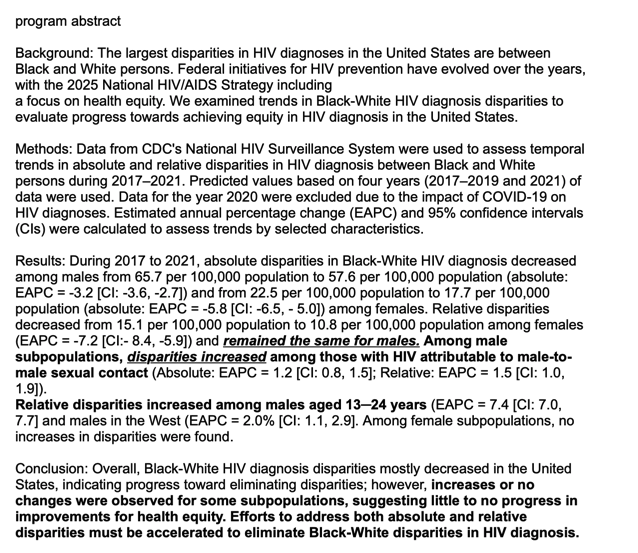
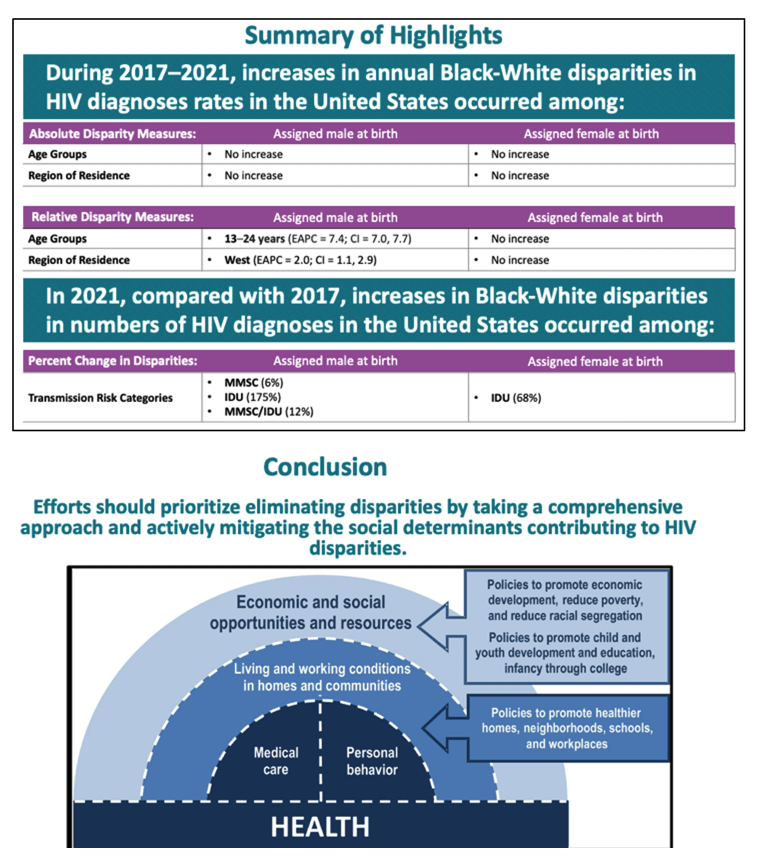
Health is shaped by many behaviors; these behaviors occur in the context of living and working conditions that influence them; and these living and working conditions are shaped by factors that reflect a person's economic and social opportunities and resources (or lack of), thereby influencing the ability to make healthier choices.
This figure illustrates relationships among some of the key factors that influence health and represent potential opportunities for reducing health disparities. To eliminate disparities, a comprehensive approach should be taken that includes actively mitigating the social determinants contributing to the disparities.
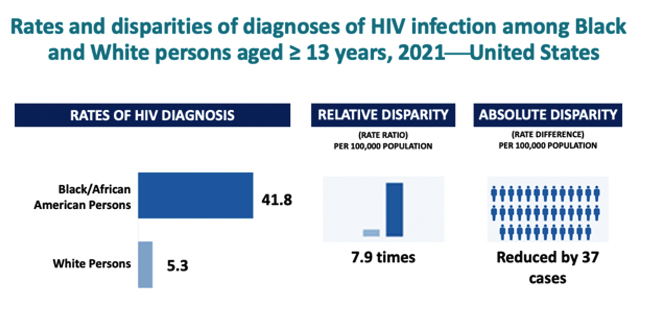
Health is shaped by many behaviors; these behaviors occur in the context of living and working conditions that influence them; and these living and working conditions are shaped by factors that reflect a person's economic and social opportunities and resources (or lack of), thereby influencing the ability to make healthier choices.
This figure illustrates relationships among some of the key factors that influence health and represent potential opportunities for reducing health disparities. To eliminate disparities, a comprehensive approach should be taken that includes actively mitigating the social determinants contributing to the disparities.
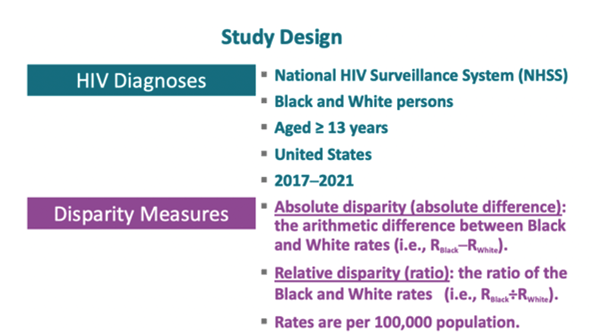
To characterize trends in Black-White disparities, diagnosed HIV infections reported to the CDC's National HIV Surveillance System were assessed. We analyzed numbers and rates of Black and White persons aged ≥
13 years with HIV infection diagnosed in the United States during 2017-2021; based on cases reported to the National HIV Surveillance System through December 2022.
Two measures were used to assess disparities in HIV diagnosis rates among Black and White persons :
•For the absolute disparity measure, we used the absolute difference which is the arithmetic difference between Black and White rates.
•For the relative disparity measure, we used the relative ratio which is the ratio of the Black and White rates.
Rates are per 100,000 population.
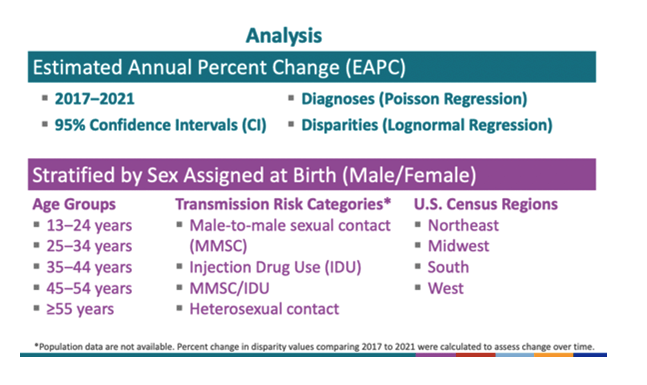
Estimated annual percent change over a 5-year period from 2017 through 2021 was used to assess temporal trends in disparities. This analysis excluded 2020 data in the assessment of trends because of the impact of the COVID-19 pandemic; the estimated annual trends were based on four years of data with a linear estimation of 2020 data. We calculated estimated annual percent changes and 95% confidence intervals using Poisson regression for Black and White HIV diagnosis rates and lognormal regression for Black-White disparities. Estimated annual percent changes were stratified by sex assigned at birth, age group, transmission category, and region of residence. Trends were deemed significant when the 95% confidence interval for the estimated annual percent change excluded 0.
For transmission risk categories, population data were not available from the U.S. census; therefore, disparity measures could not be calculated based on rates. Rather, we calculated a percent change in Black-White disparity in HIV diagnosis numbers comparing 2017 to 2021 to assess change over time.

For the results, we discuss both the absolute and relative disparity trends, we discuss increases and decreases for the disparity measures, but the focus is on any Black-White disparities that showed an increasing trend in either the absolute or relative disparity measure, or any transmission category with an increasing percent change.
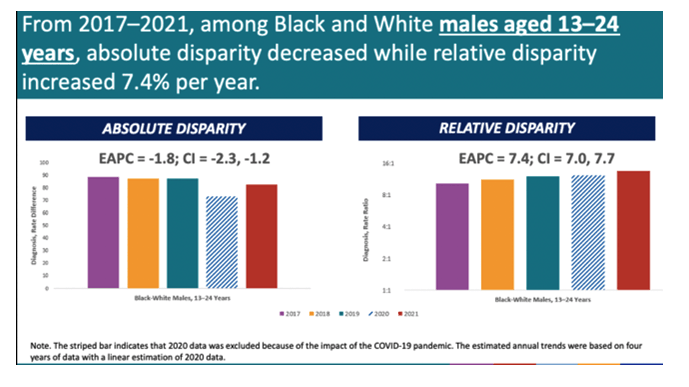
By age group, among Black and White males aged 13-24 years, the absolute disparity trend decreased 1.8% per year while the relative disparity trend increased 7.4% per year from 2017 to 2021.
This occurred because, although the HIV diagnosis rates declined in both groups; Black males aged 13-24 years had higher rates that decreased at a slower pace than the rates among White males aged 13-24 years.
So, the rate of improvement was smaller for Black males aged 13-24 years and only an increase in relative disparity was observed.
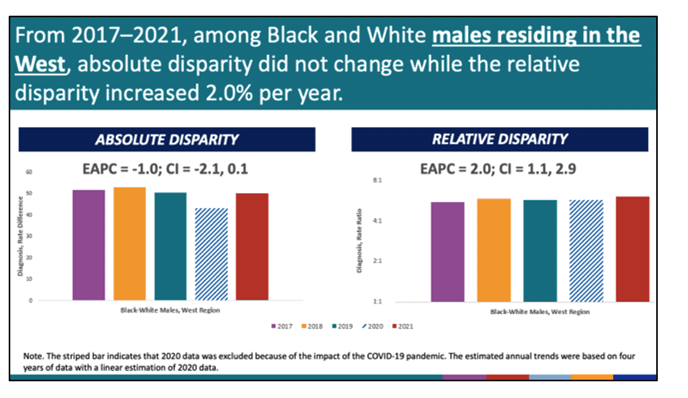
By U.S. Census Region, among Black and White males residing in the West, the absolute disparity trend did not change while the relative disparity trend increased 2.0% per year from 2017 to 2021.
This occurred because, while the HIV diagnosis rate significantly declined among White males residing in the West, the decrease of a similar magnitude among Black males was not significant, in part due to the higher rates.
Thus, improvement in annual HIV diagnosis rates was smaller for Black males residing in the West and only an increase in relative disparity was observed.
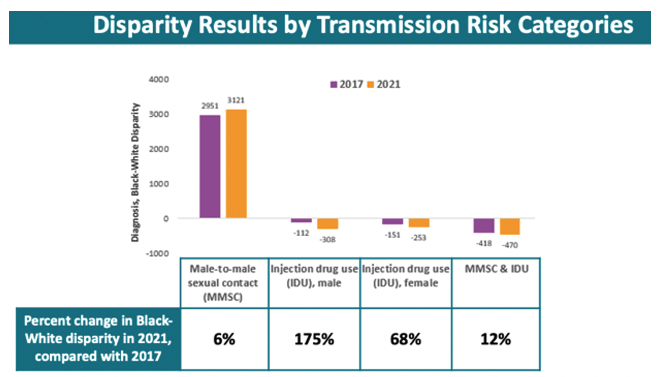
By transmission risk category, the percent change in Black-White disparity in HIV diagnosis numbers comparing 2017 to 2021, showed an increasing trend for several transmission risk categories.
HIV diagnoses attributed to male-to-male sexual contact, to injection drug use for both males and females, and to the combined category of male-to-male sexual contact and injection drug use increased - with the highest increase being among males who inject drugs.
In the figure, the negative numbers indicate that the higher number of HIV diagnoses were among White persons rather than Black persons.
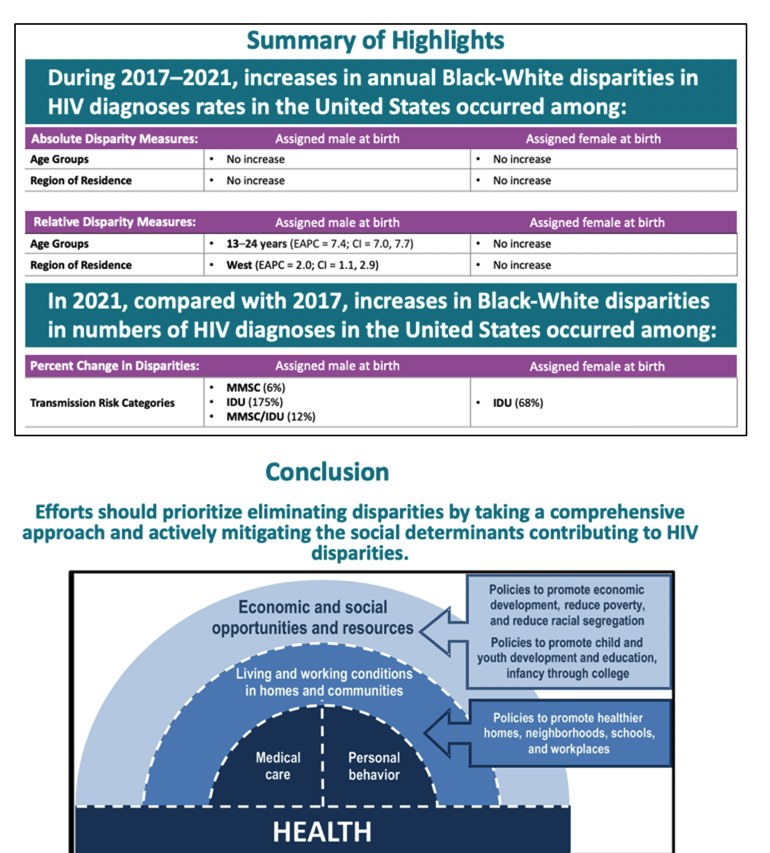
Health is shaped by many behaviors; these behaviors occur in the context of living and working conditions that influence them; and these living and working conditions are shaped by factors that reflect a person's economic and social opportunities and resources (or lack of), thereby influencing the ability to make healthier choices.
This figure illustrates relationships among some of the key factors that influence health and represent potential opportunities for reducing health disparities. To eliminate disparities, a comprehensive approach should be taken that includes actively mitigating the social determinants contributing to the disparities
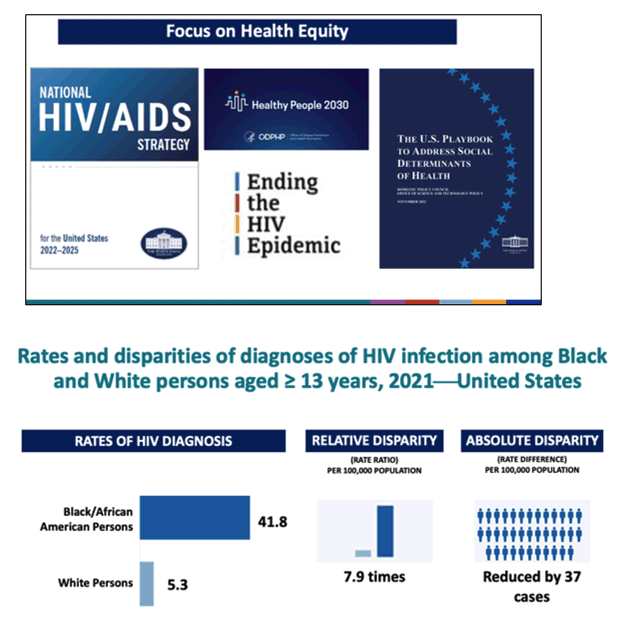
When considering HIV disparities, diagnoses of HIV infection continues to disproportionately affect Black/African American persons (hereafter referred to as Black person's) in the United States. In 2021, among persons aged ≥
13 years, Black persons had the highest rate of HIV diagnoses in the United States at 41.8 per 100,000 population. This is 7.9 times the rate of White persons. Thus, if Black persons had a similar rate as White persons, HIV diagnoses would have been reduced by 37 cases per 100,000 population.
We wanted to take a closer look at Black-White disparities in HIV diagnoses; our objective was to see if they are getting worse, in other words increasing, between Black-White subpopulations.
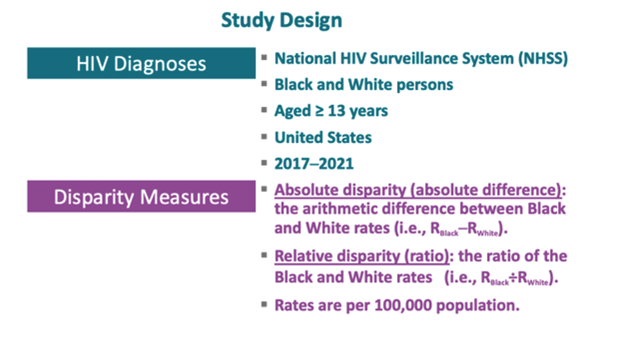
To characterize trends in Black-White disparities, diagnosed HIV infections reported to the CDC's National HIV Surveillance System were assessed. We analyzed numbers and rates of Black and White persons aged ≥
13 years with HIV infection diagnosed in the United States during 2017-2021; based on cases reported to the National HIV Surveillance System through December 2022.
Two measures were used to assess disparities in HIV diagnosis rates among Black and White persons :
•For the absolute disparity measure, we used the absolute difference which is the arithmetic difference between Black and White rates.
•For the relative disparity measure, we used the relative ratio which is the ratio of the Black and White rates.
Rates are per 100,000 population.
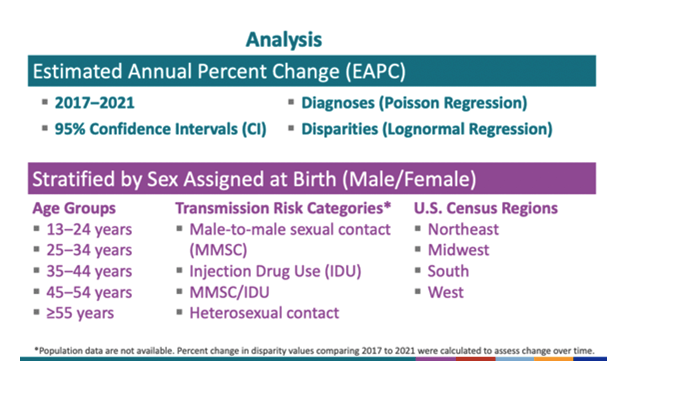
Estimated annual percent change over a 5-year period from 2017 through 2021 was used to assess temporal trends in disparities. This analysis excluded 2020 data in the assessment of trends because of the impact of the COVID-19 pandemic; the estimated annual trends were based on four years of data with a linear estimation of 2020 data. We calculated estimated annual percent changes and 95% confidence intervals using Poisson regression for Black and White HIV diagnosis rates and lognormal regression for Black-White disparities. Estimated annual percent changes were stratified by sex assigned at birth, age group, transmission category, and region of residence. Trends were deemed significant when the 95% confidence interval for the estimated annual percent change excluded 0.
For transmission risk categories, population data were not available from the U.S. census; therefore, disparity measures could not be calculated based on rates. Rather, we calculated a percent change in Black-White disparity in HIV diagnosis numbers comparing 2017 to 2021 to assess change over time.
|
| |
|
 |
 |
|
|